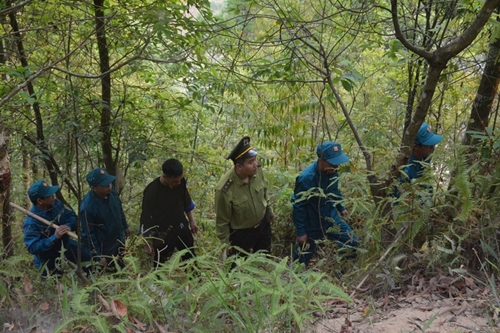With a total natural forest area of nearly 83,000 hectares, Mu Cang Chai has a lot of potential and advantages in forestry development. Thereby, the district has attached much significance to managing, protecting and developing the forests. Thanks to the implementation of effective measures, forest protection and development have obtained positive outcomes. Particularly, the forest coverage in the whole district has increased, local people’s awareness of forest protection and development has been raised and many agricultural and forestry models have been applied, bringing practical results.
    |
 |
|
Staff of the Mu Cang Chai Ranger Station and militiamen of Mo De commune conducting patrol in the forest |
The Che Tao Species and Habitat Conservation Area, located on the Hoang Lien Son mountain range, is evaluated as a beautiful natural forest in the Northwestern region. This area stretches along the H’mong-inhabited communes of Nam Khat, Che Tao, Lao Chai, Pung Luong and De Xu Phinh, with plentiful and rare flora and fauna. Among them, there are many species recorded in the Vietnam Red Book. In order to preserve nature and develop eco-tourism in a sustainable manner, Mu Cang Chai district has regularly promoted dissemination and education to raise residents and visitors’ awareness of forest protection.
According to Chang The Suu, Chairman of the Nam Khat commune People’s Council, to protect forests and preserve the ecosystem to develop tourism, Nam Khat commune has established forest protection teams in nine villages to regularly conduct patrols in belts bordering neighboring localities.
In recent years, the tourism experience model in Mo De commune has seen strong development, contributing to raising local people’s income and their awareness of forest protection and development.
Sung A Hua, the owner of a homestay in Hang Sung village, Mo De commune, shared that in Mu Cang Chai, the forests are green and the service is attentive, so visitors are satisfied. Local people have got a share of cake from forests, so they have heightened their awareness and responsibilities of protecting and not cutting down forests. Visitors who like natural forests will come back .
Giang A De, a ranger from Mu Cang Chai Ranger Station, shared that the station has closely coordinated with local authorities of communes to timely prevent and strictly handle cases of deforestation. Together with setting up forest protection teams, the station has collaborated with functional agencies of the district to carry out dissemination activities to raise people’s awareness and encourage people to sign commitment documents to protect forest resources.
The station has focused on promoting afforestation and forest regeneration and taken measures to raise forest coverage. Meanwhile, they have built a model of protecting forests associated with community tourism and multiplied the model throughout the district, thereby attracting more visitors, boosting eco-tourism and community-tourism development, and creating sustainable livelihood for local people.
According to Nong Viet Yen, Secretary of the Mu Cang Cai district Party Committee, in order to effectively exploit local tourism potential, especially those from forests, the party committee has continued to create favorable conditions for tourism development to meet various needs of visitors. In addition, the district has concentrated on investing in areas with many primeval forests to maximize locally available advantages and preserve the natural ecosystem while combining forest protection with sustainable tourism economic development.
Translated by Quynh Oanh